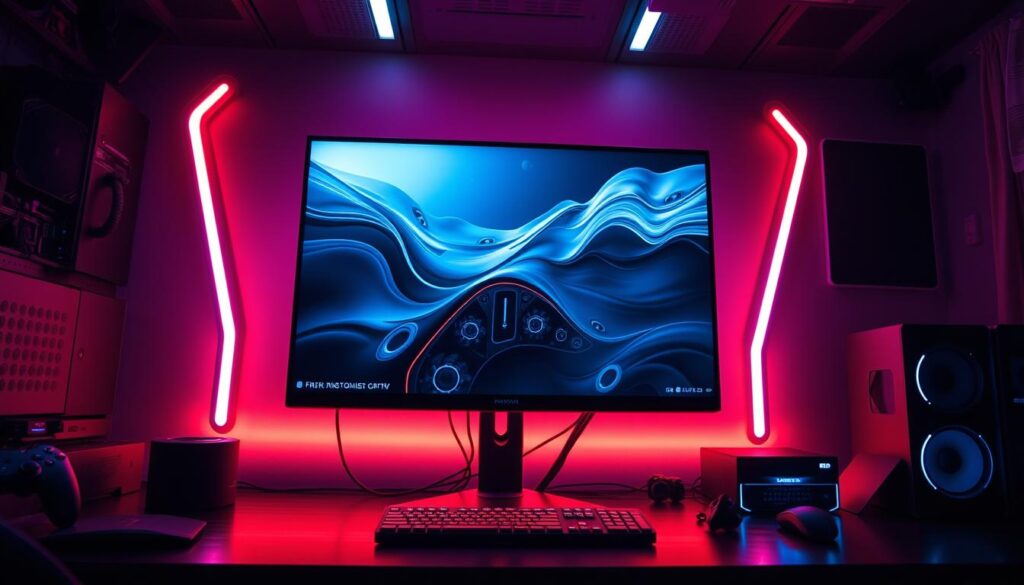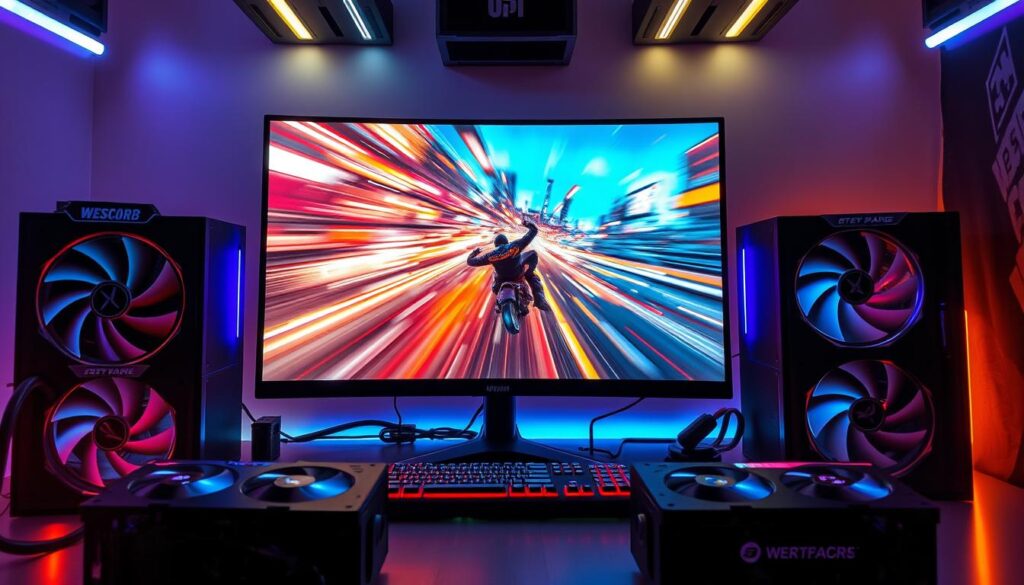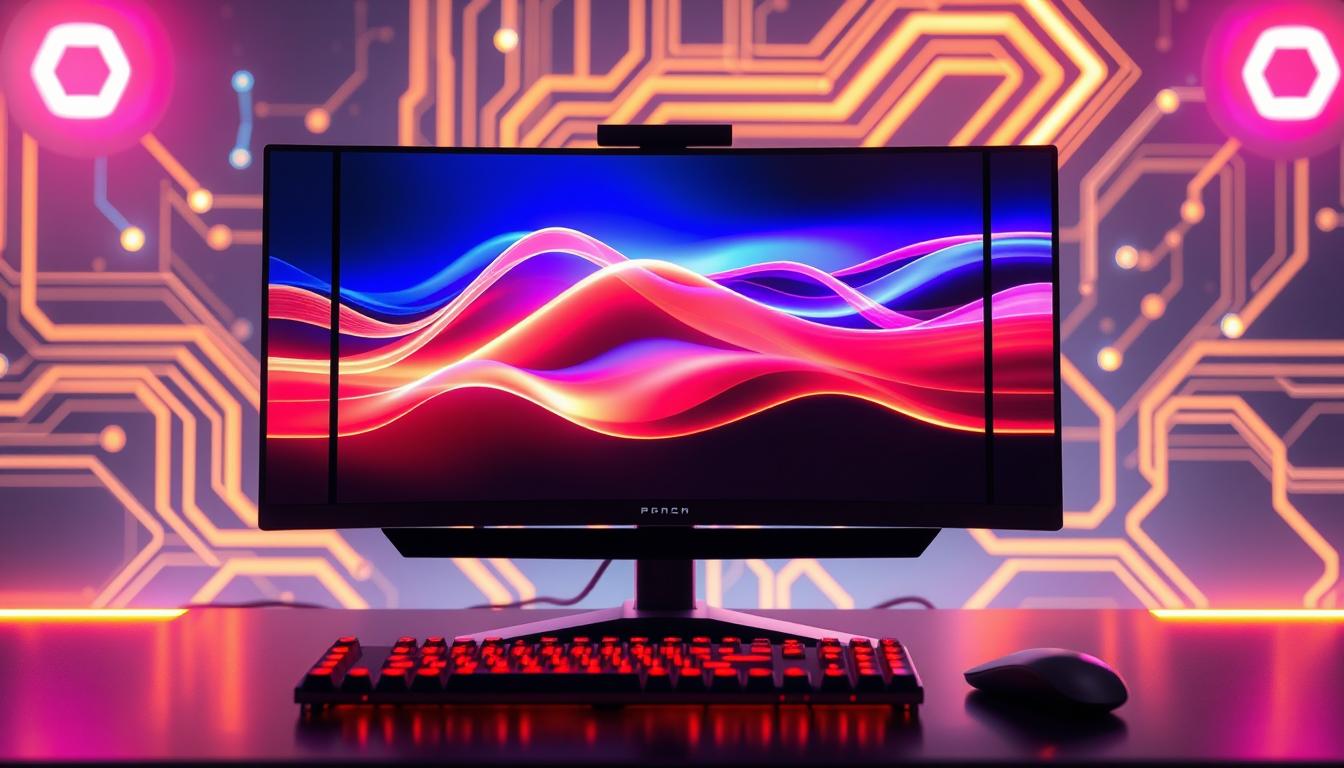What is Vertical Sync? Think about playing your favorite video game while enduring annoying screen tearing. Vertical synchronization, or V-Sync, is groundbreaking for gamers and visual lovers. I would like you to understand what it is and how it functions. Let’s now investigate how it enhances our gaming.
Important Takeaways
- A display technique called vertical sync, or V-Sync, guarantees a fluid visual experience.
- Understanding what is vertical sync and its significance can benefit both graphics fans and gamers.
- Vertical sync helps to avoid screen tearing and improve display performance.
- What does vertical sync do? It synchronizes the frame rate with the monitor’s refresh rate.
- Vertical sync is essential for high-refresh-rate monitors and powerful graphics cards.
- Gamers can have a more smooth and captivating experience by utilizing vertical sync.
Why is Vertical Sync? Important and What Is It?
Tearing in the screen in graphics can be resolved via a technology called Vertical Sync, or V-Sync. When the graphics and display are out of sync, screen tearing occurs. This results in a torn or distorted image. V-Sync makes sure the monitor and graphics are in sync, giving a smoother look.
V-Sync is key for better graphics, especially in games. Games need fast graphics and smooth play. V-Sync helps by reducing screen tearing and making images stable. This makes games look better and feel smoother, reducing eye strain too.
- Reduced screen tearing and distorted images
- Improved visual quality and stability
- Enhanced gaming performance and reduced eye strain
Next, we’ll dive into how V-Sync works. We’ll see how it makes visuals smoother and more stable.
| Technology | Description |
|---|---|
| Vertical Sync | Display synchronization technology that eliminates screen tearing |
| Monitor Refresh Rate | The rate at which the monitor updates the image on the screen |
| Graphics Frame Rate | The rate at which the graphics card renders frames |
The Technical Mechanics Behind Vertical Sync
Understanding Vertical Sync’s technical side is key for top performance. Graphics card settings are crucial in this process. Users can improve their game experience by adjusting these options.
To accomplish this, take the following actions:
- Access the graphics card settings through the control panel or settings menu.
- Adjust the frame rate optimization settings to correspond with the refresh rate of the monitor.
- To align the frame rate with the refresh rate of the monitor, turn on Vertical Sync.
Users can have a flawless gaming experience by following these methods. This is with minimal screen tearing and optimal performance.
| Configuring | An explanation |
|---|---|
| Graphics Card Settings | modifying the graphics card’s settings to maximize performance and frame rate. |
| Frame Rate Optimization | For a more seamless experience, change the frame rate to correspond with the refresh rate of the monitor. |
Different Types of Vertical Sync Technologies
Vertical Sync technologies have grown to fight screen tearing and improve display sync. It’s key to know the various Vertical Sync types to enhance video game play. Display sync tech is vital for better gaming.
Traditional V-Sync
Traditional V-Sync is the oldest Vertical Sync tech. It synchronizes the refresh rate of the monitor with the frame rate of the graphics card. Although it reduces screen tearing, it isn’t always effective.
Adaptive Sync
A more recent Vertical Sync technology is called Adaptive Sync. It modifies the refresh rate of the monitor according to the frame rate of the graphics card. This tech reduces screen tearing and improves display sync.
G-Sync and FreeSync
G-Sync and FreeSync are top Adaptive Sync techs. They work with certain graphics cards and monitors for smooth gaming. These techs cut down screen tearing and boost display sync for better gaming.
Knowing the different Vertical Sync techs helps gamers pick the best for their needs. This improves their gaming experience.
Common Display Issues Solved by Vertical Sync
Vertical Sync fixes common display problems, making games run smoothly. It addresses a major problem for gamers: screen stuttering. It minimizes tearing and stuttering by syncing the frame rate to the monitor’s refresh rate.
Using Vertical Sync brings many benefits:
- Less screen stuttering
- No more screen tearing
- Better visual quality
For a smooth gameplay experience, Vertical Sync is key. It eases the graphics card’s workload, making games more enjoyable. It helps gamers stay in the game, without distractions from visual problems.
Vertical Sync makes gaming much more enjoyable. It fixes problems like tearing and stuttering, therefore gamers need it.

How to Turn on and Set Up Vertical Sync
You need to know How to turn on and set up Vertical Sync If you’d want to obtain the most out of it. This involves tweaking graphics card settings for better performance. The aim is to make gaming smooth by syncing the frame rate with the monitor refresh rate.
Begin by going into your graphics card settings to turn on Vertical Sync. You might see it as “Vertical Sync” or “V-Sync.” After turning it on, tweak the frame rate optimization settings for a better gaming feel. It’s key to balance the frame rate with the monitor refresh rate to prevent screen tearing and input lag.
- Adjust the graphics card settings to optimize performance
- Enable Vertical Sync in game-specific settings for a smoother experience
- Monitor the frame rate and adjust the settings as needed to maintain a stable frame rate optimization
You may experience seamless gameplay with Vertical Sync by following these procedures and adjusting your graphics card settings and monitor refresh rate. Remember to experiment with several settings to determine which one works best for your machine.
| Configuring | An explanation |
|---|---|
| Vertical Sync | Turns on or off Syncing Vertically |
| Optimization of Frame Rate | optimizes performance by modifying the frame rate. |
| Track the Refresh Rate | determines the monitor’s refresh rate. |
The Impact of Vertical Sync on Gaming Performance
Vertical Sync is key to better video game performance. By synchronizing the game’s frame rate with the monitor’s refresh rate, it creates fluid gaming. This results in a smooth and captivating experience. It is particularly crucial for fast-paced games since it reduces stuttering and screen tearing.
Vertical Sync also helps in optimizing frame rates. It limits the frame rate to the monitor’s refresh rate. This reduces input lag, which is bad for gaming performance. For games needing quick reflexes, Vertical Sync makes the experience more responsive and engaging.

- Reduced screen tearing and stuttering
- Improved frame rate optimization
- Enhanced smooth gameplay experience
In summary, Vertical Sync is vital for gamers aiming for top video game performance. It ensures a smooth experience and optimizes frame rates. This technology elevates gaming to new heights.
| Technology | Benefits |
|---|---|
| Vertical Sync | Reduced screen tearing, improved frame rate optimization |
| Frame Rate Optimization | Enhanced smooth gameplay experience, reduced input lag effects |
Troubleshooting Vertical Sync Problems
Vertical Sync issues can be really frustrating. They often cause screen tearing or mess with the display’s smoothness. To fix these problems, it’s key to know about display synchronization technology and how to tweak graphics card settings for better performance.
Uneven frame rates, input lag, and screen tearing are a few typical issues with vertical sync. To troubleshoot certain issues, use these steps:
- Set the frame rate cap to the refresh rate of the display and enable Vertical Sync in the graphics card settings.
- To make sure the graphics drivers are compatible with the display synchronization technology, update them to the most recent version.
- To avoid conflicts with Vertical Sync, turn off any overlapping synchronization methods, such G-Sync or FreeSync.
By following these tips, you can solve common Vertical Sync problems. This will make the visual experience more fluid and tear-free for you. For optimal results, always monitor the performance of your system and adjust the settings as necessary.
In Conclusion: What is Vertical Sync?
In this guide, we’ve delved into vertical sync, a key display tech for smooth visuals. Now, readers know how to use it for better computing and gaming. This tech ensures a smooth visual experience.
Vertical sync helps avoid screen tearing and keeps graphics and display in sync. It’s essential for top-notch visuals. With the right settings, users can say goodbye to annoying visual glitches and enjoy smooth interactions.
The many vertical sync modes, such as V-Sync and G-Sync, have been discussed. The secret is striking the correct balance between quality and performance. This way, users can customize their vertical sync settings to fit their needs.
This article has prepared readers to maximize vertical sync technology. They can now enhance their computing and gaming with it. With this knowledge, they can navigate the visual world smoothly and enjoy the benefits of vertical sync.
FAQ
Describe Vertical Sync.
A piece of technology known as Vertical Sync prevents screen tearing and smoothest out images. It lines up the rate of refresh of the show with the frame rate of the graphics card. In this manner, every frame is rendered completely before being displayed.
What is the process of Vertical Sync?
Aligning vertically the refresh rate of the show with the frame delivery of the graphics card. It guarantees that a new frame is only sent by the graphics card when the display is ready. This prevents screen tearing and other visual issues.
What is the purpose of Vertical Sync?
The basic purpose of Vertical Sync is to get rid of screen tearing. Specifically in games and apps with a lot of graphics, It produces fluid and smooth images. This is because it syncs the graphics card and display, avoiding visual glitches.
How does Vertical Sync affect game performance?
Vertical Sync can both help and hinder game performance. It can make games smoother and tear-free. But, it can also introduce input lag and limit the frame rate, depending on your setup.
Which kinds of Vertical Sync technology are there?
Conventional V-Sync, Adaptive Sync, G-Sync, and FreeSync are merely a smattering of the several Vertical Sync solutions. Each has advantages and cons of its own. The hardware and software of your system will determine which solution is best.
How can I enable and adjust Vertical Sync?
You need to update the settings in your graphics card control panel or in-game settings to switch on and adjust Vertical Sync. It might be required to select the suitable Vertical Sync setting, change the frame rate, and verify that the update rate of you has an accurate display.
How can I fix problems with Vertical Sync?
Consider troubleshooting for problems with the vertical sync, such as stammering or screen tearing. Verify the settings on your graphics card to ensure your display’s refresh rate is suitable and play with different Vertical Sync settings for your applications or games.







Your point of view caught my eye and was very interesting. Thanks. I have a question for you.